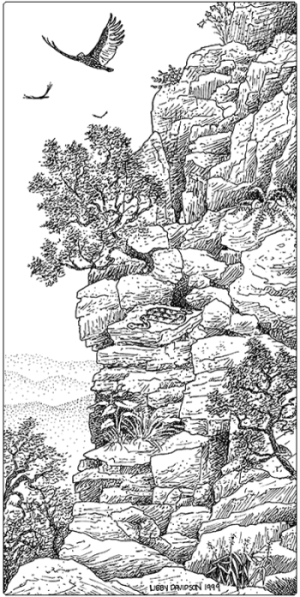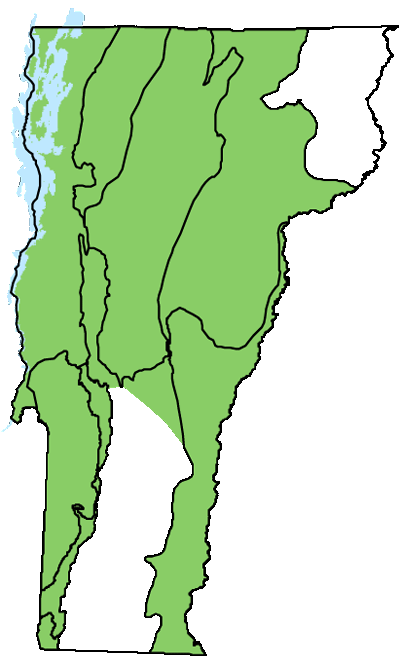Ecology and Physical Setting 
These are calcareous (limestone, marble, dolostone, or calcareous schist) cliffs of the warmer regions of Vermont. They are found at elevations as high as 2,000 feet, but most are considerably lower. In physical characteristics and vegetative structure, they are very similar to other kinds of cliffs, but calcium-rich rocks weather faster than other kinds of rock, so there is greater potential for soil development in cracks and on ledges. Temperate Calcareous Cliffs vary in moisture availability and shade but have many characteristic plants that distinguish them from acidic or boreal cliffs.
Vegetation
Temperate Calcareous Cliffs are favorite places for botanizing since their overall diversity is high and several conspicuous and interesting plants grow on them or in the talus below them. Botanists know these cliffs for their rock-dwelling ferns, including wall-rue, walking fern, bulblet fern, and purple cliffbrake. These warm, sunny cliffs also tend to harbor plant species, such as early saxifrage and wild columbine, that flower early in the spring. A few small trees, like stunted and gnarled (and potentially very old) northern white cedars, along with scattered low shrubs, grow on ledges or in cracks where soil has accumulated.
Mosses, liverworts, and lichens may be common on Temperate Calcareous Cliffs. Some mosses and liverworts prefer moist, shaded areas, but others can withstand extended periods of desiccation.
Wildlife Habitat
Crevices in these warm-climate cliffs provide summer roosting sites for eastern small-footed bats. Peregrine falcons and common ravens both nest on exposed cliff ledges. Peregrines lay their eggs directly on the rock surface and ravens build deep nests of sticks lined with grass, moss, and animal hair. In contrast, turkey vultures nest in secluded locations that are seldom seen, including crevices in the cliff faces, inside hollow trees, and in caves. Although eastern phoebes nest primarily on sheltered surfaces of human structures, they also nest on small cliffs in or near the woods with shelves and overhanging shelter.

Related Communities
- Temperate Acidic Cliffs are less diverse and generally lack calcium-loving plants.
- Temperate Calcareous Outcrops are often found associated with Temperate Calcareous Cliffs. Outcrops have slopes of less than 60 degrees.
Conservation Status and Management Considerations
Rock climbing can be a threat to Temperate Calcareous Cliffs, as can recreational wildflower hunting. Temperate Calcareous Cliffs should be viewed from a distance or from their bases. Several examples of Temperate Calcareous Cliff are protected by The Nature Conservancy and other organizations and agencies.
Distribution/Abundance
Temperate Calcareous Cliffs are found in all but the coldest and most acidic regions of Vermont. The largest and best examples are found in the Champlain Valley. Similar communities are found in the St. Lawrence lowlands, Massachusetts, Connecticut, and New York, and west into the Great Lakes region.
Characteristic Plants
Trees
Northern white cedar – Thuja occidentalis
White ash – Fraxinus americana
Eastern red cedar – Juniperus virginiana
Hophornbeam – Ostrya virginiana
Shrubs and Woody Vines
Virginia creeper – Parthenocissus quinquefolia
Purple clematis – Clematis occidentalis
Round-leaved dogwood – Cornus rugosa
Herbs
Ebony sedge – Carex eburnea
Wild columbine – Aquilegia canadensis
Bulblet fern – Cystopteris bulbifera
Wall-rue – Asplenium ruta-muraria
Steller’s cliffbrake – Cryptogramma stelleri
Hairy rock cress – Arabis pycnocarpa
Maidenhair spleenwort – Asplenium trichomanes
Smooth cliffbrake – Pellaea glabella
Purple-stemmed cliffbrake – Pellaea atropurpurea
Harebell – Campanula rotundifolia
Herb Robert – Geranium robertianum
Pellitory – Parietaria pensylvanica
Slender wheatgrass – Elymus trachycaulus
Canada anemone – Anemone canadensis
Kalm’s brome grass – Bromus kalmii
White snakeroot – Ageratina altissima
Early saxifrage – Micranthes virginiensis
Walking fern – Asplenium rhizophyllum
Bryophytes
Moss – Abietinella abietina
Moss – Anomodon attenuatus
Moss – Anomodon viticulosus
Moss – Encalypta procera
Moss – Gymnostomum aeruginosum
Moss – Myurella sibirica
Moss – Plagiopus oederiana
Moss – Thuidium recognitum
Moss – Tortella tortuosa
Liverwort – Preissia quadrata
Rare and Uncommon Plants
Wall-rue – Asplenium ruta-muraria
Steller’s cliffbrake – Cryptogramma stelleri
Smooth cliffbrake – Pellaea glabella
Purple-stemmed cliffbrake – Pellaea atropurpurea
Missouri rock-cress – Borodinia missouriensis
Purple clematis – Clematis occidentalis
Strawberry-blite – Blitum capitatum
Drummond’s rock-cress – Arabis drummondii
Supple panic grass – Panicum flexile
White camas – Anticlea glauca
Graham’s rockcress – Boechera grahamii
Small-flowered bitter cress – Cardamine parviflora
Golden corydalis – Corydalis aurea
Rock whitlow-grass – Draba arabisans
Longleaf bluet – Houstonia longifolia
Green adder’s mouth – Malaxis unifolia
Rock muhlenbergia – Muhlenbergia sobolifera
Snowy aster – Solidago ptarmicoides
Prairie wedge grass – Sphenopholis obtusata
Associated Animals
Eastern phoebe – Sayornis phoebe
Common raven – Corvus corax
Turkey vulture – Cathartes aura
Rare and Uncommon Animals
Eastern small-footed bat – Myotis leibii
Peregrine falcon – Falco peregrinus
Columbine duskywing – Erynnis lucilius
Places to Visit
Eagle Mountain, Milton, Lake Champlain Land Trust
Shelburne Pond Preserve, Shelburne, University of Vermont and The Nature Conservancy.
Mount Philo State Park, Charlotte, Vermont Department of Forests, Parks, and Recreation (VDFPR)
Mount Independence State Historic Site, Orwell, Vermont Department of Historic Preservation
Taconic Mountain Ramble State Park, Hubbardton, VDFPR
